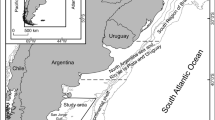Abstract
Bayesian surplus production models were developed for assessing the North Pacific swordfish population under alternative scenarios: a single-stock scenario and a two-stock scenario with subareas that represented the western central and eastern Pacific Ocean regions. Biomass production was modeled with a three-parameter production model that allowed production to vary from the symmetric Schaefer curve using an estimated shape parameter. Lognormal prior distributions for intrinsic growth rate and carrying capacity were assumed. Goodness-of-fit diagnostics were developed for comparing the fits of alternative model configurations based on the root-mean squared error of catch per unit effort (CPUE) fits and the standardized CPUE residuals. Production model fits for 1952–2006 indicated that the Japanese longline CPUE numbers were influential under each stock scenario because these scenarios were the longest time series of relative abundance indices. Model results also indicated that assumptions about the prior means for intrinsic growth rate and carrying capacity may be important based on the model configuration.






Similar content being viewed by others
References
Ward P, Porter JM, Elscot S (2000) Broadbill swordfish: status of established fisheries and lessons for developing fisheries. Fish Fish 1:317–336
Wang SP, Sun CL, Punt A, Yeh SZ (2005) Evaluation of a sex-specific age-structured assessment method for the swordfish, Xiphias gladius, in the North Pacific Ocean. Fish Res 73:79–97
Wang SP, Sun CL, Punt A, Yeh SZ (2007) Application of the sex-specific age- structured assessment method for swordfish, Xiphias gladius, in the North Pacific Ocean. Fish Res 84:282–300
Ludwig D, Walters C (1985) Are age-structured models appropriate for catch-effort data? Can J Fish Aquat Sci 42:1066–1072
Reeb C, Arcangeli L, Block B (2000) Structure and migration corridors in Pacific populations of the swordfish Xiphias gladius, as inferred through analyses of mitochondrial DNA. Mar Biol 136:1123–1131
Alvarado BJ, Hinton M, Greig T (2006) Evidence of spatial genetic heterogeneity in Pacific swordfish (Xiphias gladius) revealed by the analysis of LDH-A sequences. Bull Mar Sci 79:493–503
Ichinokawa M, Brodziak J (2010) Using adaptive area stratification to standardize catch rates with application to North Pacific swordfish (Xiphias gladius). Fish Res. doi:10.1016/j.fishres.2010-08-001
Waples R (1998) Separating the wheat from the chaff: patterns of genetic differentiation in high gene flow species. J Hered 89:438–450
Hoenig J, Warren W (1994) Bayesian and related approaches to fitting surplus production models. Can J Fish Aquat Sci 51:1823–1831
McAllister M, Kirkwood G (1998) Bayesian stock assessment: a review and example application using the logistic model. ICES J Mar Sci 55:1031–1060
Ellison A (2004) Bayesian inference in ecology. Ecol Lett 7:509–520
Hilborn R, Peterman R (1996) The development of scientific advice with incomplete information in the context of the precautionary approach. FAO Fish Tech Pap No. 350/2. Food and Agriculture Organization of the UN, Rome, pp 77–102
Meyer R, Millar R (1999) BUGS in Bayesian stock assessments. Can J Fish Aquat Sci 56:1078–1086
Brodziak J (2007) An investigation of alternative production models to assess the Hawaiian bottomfish complex. Pacific Islands Fish Sci Cent Admin Rep H-07-01. Pacific Islands Fisheries Science Center, National Marine Fisheries Services NOAA, Honolulu
Maunder M, Starr P (2003) Fitting fisheries models to standardized CPUE abundance indices. Fish Res 63:43–50
McAllister M, Babcock E, Pikitch E, Prager M (2000) Application of a non-equilibrium generalized production model to South and North Atlantic swordfish: combining Bayesian and demographic methods for parameter estimation. Col Vol Sci Pap ICCAT 51:1523–1550
McAllister M, Pikitch E, Babcock E (2001) Using demographic methods to construct Bayesian priors for the intrinsic rate of increase in the Schaefer model and implications for stock rebuilding. Can J Fish Aquat Sci 58:1871–1890
DeMartini E, Uchiyama J, Williams H (2000) Sexual maturity, sex ratio, and size composition of swordfish, Xiphias gladius, caught by the Hawaii-based pelagic longline fishery. Fish Bull 98:489–506
DeMartini E, Uchiyama J, Humphreys R, Sampaga J, Williams H (2007) Age and growth of swordfish (Xiphias gladius) caught by the Hawaii-based pelagic longline fishery. Fish Bull 105:356–367
Congdon P (2001) Bayesian statistical modeling. Wiley, New York
Gilks WR, Richardson S, Spiegelhalter DJ (1996) Markov Chain Monte Carlo in practice. Chapman and Hall, London
Lunn DJ, Thomas A, Best N, Spiegelhalter D (2000) WinBUGS—a Bayesian modelling framework: concepts, structure, and extensibility. Stat Comput 10:325–337
Gelman A, Rubin D (1992) Inference from iterative simulation using multiple sequences. Stat Sci 7:457–511
Heidelberger P, Welch P (1992) Simulation run length control in the presence of an initial transient. Oper Res 31:1109–1144
Booth A, Quinn TII (2006) Maximum likelihood and Bayesian approaches to stock assessment when data are questionable. Fish Res 80:169–181
Arrizabalaga H, Restrepo V, Maunder M, Majkowski J (2009) Using stock assessment information to assess fishing capacity of tuna fisheries. ICES J Mar Sci 66:1959–1966
Author information
Authors and Affiliations
Corresponding author
Rights and permissions
About this article
Cite this article
Brodziak, J., Ishimura, G. Development of Bayesian production models for assessing the North Pacific swordfish population. Fish Sci 77, 23–34 (2011). https://doi.org/10.1007/s12562-010-0300-0
Received:
Accepted:
Published:
Issue Date:
DOI: https://doi.org/10.1007/s12562-010-0300-0




